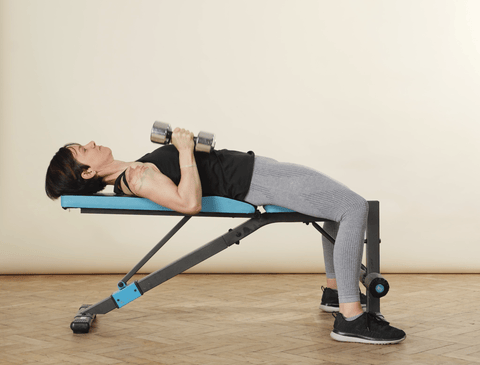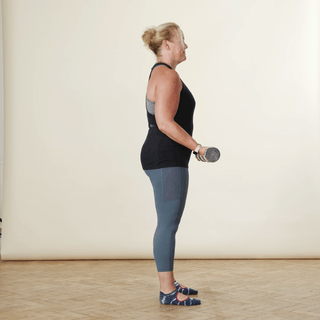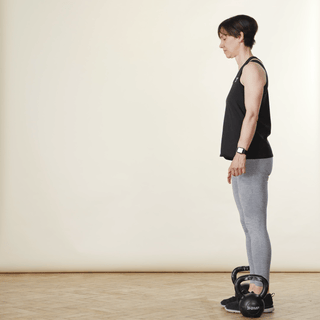

Eight of the best exercises for toning your arms as you get older from a personal trainer - and how to do them.
Exercise helps us to look good and feel good. As a personal trainer, a common goal I hear is “I want to tone my arms”, or “I want bigger biceps”.
It’s not uncommon for people to feel self-conscious about their arms and cover them up with longer sleeves, even during hot weather. But improvements to your arms’ appearance can be achieved by adding the right exercises to your regime.
I love working my upper body. There are so many benefits to strength training and for me, the ability to lift heavy things with relative ease is right up there, along with the confidence it brings.
Level: suitable for all levels
Equipment needed: dumbbells, optional kettlebells and resistance bands. You can use water bottles in place of dumbbells, but just make sure you can grip them properly.
Areas worked: biceps, triceps (under arms), forearms, deltoids (front top of shoulders), grip
Equipment needed: dumbbells, optional kettlebells and resistance bands. You can use water bottles in place of dumbbells, but just make sure you can grip them properly.
Before you begin:

Works: triceps (small muscles on underside of arms)
Modifications/variations: Use a lighter weight if needed, a pair of dumbbells to challenge yourself, or the cable machine for a heavier weight.

Works: triceps, core
Modifications/variations: Use the rope attachment on the cable machine instead. As you pull down, think about splitting the rope – but keep those elbows tight to your side.

Works: triceps, deltoids (front of shoulders), biceps
Modifications/variations: You can alternate arms for stabilisation work. You could also use a resistance band for this exercise – lie with the band across your back, just above waist height, hold the handles and press from there.

Works: biceps
Modifications /variations: You can use a barbell for the same exercise. You can also vary your hand position, turning your palms in to face each other to perform hammer curls instead. You can also perform this seated.

Works: biceps, forearms
Modifications/ variations: You can perform this exercise seated, but you’ll miss out on making the core muscles work.


Works: biceps, triceps, deltoids, forearms
Modifications/variations: Use lighter dumbbells if needed.

Works: forearms, grip, biceps, triceps, core
Modifications/variations: You can offset the weights – use one heavier and one lighter – for an extra challenge to your core muscles. Just remember to put the weights down and swap sides! You can also march on the spot if space is an issue.
Set a timer for five minutes and perform the following circuit as many times as possible in that time. Rest 20 seconds between moves (that will be transition time).
For the arm exercises, you’ll need a variety of weight sizes. How heavy or light the weight you lift is depends on three things: your ability, the size of the muscles being worked, and the distance of the weight from your body.
Some muscles, such as the triceps, are relatively small. If you’re performing an exercise that isolates these, you’ll need a lighter weight.
On the other hand, if you’re performing something like a barbell bicep curl, where the biceps, triceps and deltoids all work together, you can use a heavier weight. It’s harder to hold a weight at arm’s length from the body than it is against the chest.
You might remember learning about the lever and fulcrum in science at school, and it’s the same principle. For that reason, exercises like the lateral raise will use significantly lighter weights than a close grip dumbbell press.
As a guide, pick a weight that challenges you but isn’t impossible. You should be able to complete all repetitions (reps) with good form and proper technique. If the required number of reps is eight, then by number five it should start to feel like an effort. By the eighth repetition, you should need to put the weights down for a rest.
The number of sets and repetitions for any of the exercises depends on your ability, the weight used, and your goals.
For beginners, a strength training workout can consist of five or six exercises, with three sets of each.
For arm exercises, a good rep range is between eight and 12.
For seasoned lifters, or those training for pure strength (not cardio), heavier is better. A five-by-five approach works well here: five sets of five reps.
On the flip side, for those using arm exercises as part of a cardio workout (such as Body Pump, circuit training or HIIT), lighter weights and more reps is the goal. Think three or four rounds of between 12 and 15 reps (remember, light weights!).
Even if you don’t feel you need it, take it. Our central nervous system works hard in strength training and it needs time to recover between lifts. Rest for around 45-60 seconds between sets if you’re using light to medium weights, and two minutes or more if using heavier weights.